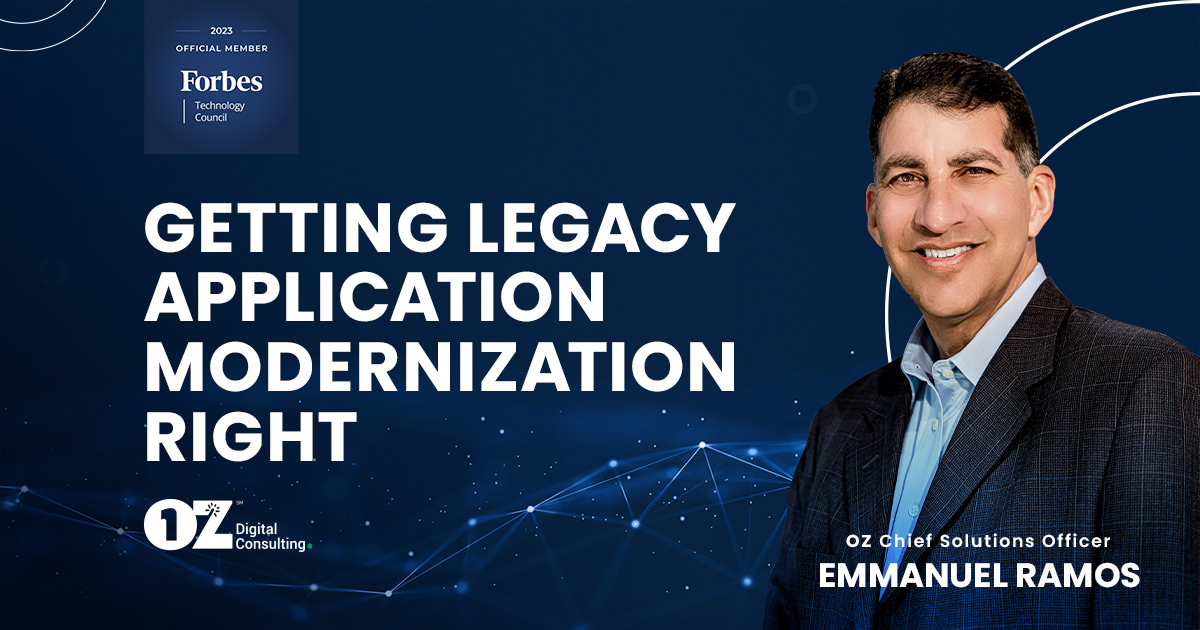Though often the lifeblood of businesses, legacy applications can also be a major source of frustration.
Which is to say, in order to maintain a competitive advantage and ensure optimal performance, it’s important to keep legacy systems up-to-date and modernized.
Is that easier said than done?
Typically, yes.
But pursuing digital transformation is a different story when you partner with experts from OZ.
To help you get started, we’ve compiled the following highly effective, often overlooked tips and tricks for legacy application modernization that will empower you to achieve greater success now—and into the future!
Benefits of Application Modernization
Application modernization is a process of updating legacy applications to take advantage of the latest technology and trends. It can provide organizations with many benefits, including—but hardly limited to—reduced downtime due to system failures or slow response times, improved performance, increased efficiency, and productivity, and cost savings.
Modernizing an application—whether by leveraging cloud computing platforms and services, utilizing automation tools to streamline processes, or implementing continuous integration/continuous delivery (CI/CD) pipelines—can improve its performance by making it more responsive and reliable. =
Application modernization also helps make systems more efficient by simplifying complex tasks that would otherwise require manual intervention or multiple steps to complete. Automation tools allow for faster processing speeds which reduce time spent on mundane tasks so employees are free to focus on higher-value activities that drive business growth. Additionally, modernized applications are easier to maintain since they use fewer resources than traditional systems do—resulting in lower operational costs over time.
Finally, application modernization can help reduce overall costs associated with maintaining legacy systems by eliminating the need for costly upgrades or repairs when something goes wrong.
With automated processes in place that continuously monitor performance metrics and optimize accordingly, businesses don’t have to worry about spending money on outdated solutions that no longer meet their needs. Additionally, new features like artificial intelligence (AI) capabilities offer further cost savings opportunities as they enable companies to automate routine tasks without having to hire additional personnel or invest in expensive hardware infrastructure upgrades.
Challenges of Application Modernization
While it can be beneficial for businesses, there are several challenges that must be addressed to ensure successful implementation.
- Complexity of Legacy Systems. Legacy systems often contain outdated code and architecture which can make them difficult to update or integrate with new technology. This complexity can lead to costly delays as developers work through the various components of the system as they identify areas where changes need to be made. Additionally, some legacy systems may have been built on proprietary platforms which further complicates matters as these platforms may no longer be supported by their original vendors.
- Data Migration Issues. Data migration is another challenge associated with application modernization projects. In many cases, data from existing databases need to be migrated into new formats to allow it to work properly with updated applications or software solutions. If not done correctly, this could result in lost or corrupted data which could have serious consequences for businesses relying on accurate information for decision-making purposes.
- Security Concerns. Potential vulnerabilities that may exist within older versions of software or hardware solutions used by legacy systems. Outdated security protocols and encryption methods should also be taken into consideration when migrating data between different environments as they could potentially expose sensitive information if not handled properly during the transition process.
Strategies for Successful Application Modernization
Application modernization is a key component of digital transformation, allowing organizations to take advantage of the latest technologies and stay competitive in today’s market.
To ensure successful application modernization, it’s important to have an effective strategy in place.
- Assess Current System Architecture and Requirements. The first step towards successful application modernization is assessing the current system architecture and requirements. This includes understanding what existing systems are used, how they interact with each other, their data structures, security protocols, and any potential issues that may arise from transitioning to new technology. By having a thorough understanding of the existing system architecture and requirements before beginning the process of modernizing applications, organizations can avoid costly mistakes down the line.
- Develop an Actionable Plan for Modernization. Once you have assessed your current system architecture and requirements it’s time to develop an actionable plan for modernization. This should include identifying which applications need updating or replacing entirely as well as outlining specific steps needed to complete these tasks such as migrating data or integrating new services into existing infrastructure. It’s also important to consider budget constraints when creating this plan so that resources are allocated appropriately throughout the process.
- Utilize automation and DevOps. These tools can be incredibly helpful during application modernization projects, streamlining processes such as testing code or deploying updates quickly across multiple environments without manual intervention from developers or IT teams. Leveraging DevOps tools like continuous integration/continuous delivery (CI/CD) pipelines can help speed up development cycles while ensuring quality control throughout all stages of software production – from coding through deployment—and reduce errors due to manual inputting along the way.
Best Practices for Application Modernization
When establishing best practices it is essential to leverage cloud computing platforms and services, which can provide a number of benefits for application modernization projects, such as scalability, cost savings, improved performance, increased efficiency, and more.
Leveraging cloud computing technologies can help organizations quickly deploy new applications or update existing ones without having to worry about hardware procurement or maintenance. Additionally, cloud-based solutions are often more secure than traditional on-premise systems due to the use of advanced security protocols.
CI/CD pipelines enable organizations to automate the process of building software from source code all the way through deployment in production environments. This automation helps reduce errors associated with manual processes while also speeding up development cycles significantly. When implementing CI/CD pipelines for application modernization projects it is important to ensure that each step in the pipeline is properly configured so that any issues can be identified early on before they become major problems down the line.
Once an application has been modernized, it is important to monitor its performance over time in order to identify any potential issues or areas where optimization may be necessary. By regularly monitoring key metrics such as response times, resource utilization levels, and error rates, organizations can quickly identify any areas where improvements need to be made to keep applications running smoothly at all times.
Additionally, by taking advantage of analytics tools like machine learning algorithms, teams can gain valuable insights into how their applications are being used which can then be used when making decisions regarding future optimizations or updates.
Conclusion
Application modernization is a critical process for businesses looking to maximize the performance of their software delivery systems.
By understanding the benefits, challenges, strategies, and best practices associated with legacy application modernization, organizations can ensure that they are taking full advantage of modern cloud platforms and technologies.
And with these tips and tricks in mind, companies can move forward confidently with their legacy application modernization projects.
Are you struggling with legacy application modernization? OZ Digital Consulting can help! Our team of experienced professionals is here to provide the best solutions and advice for your business needs. From data analytics, enterprise integration and intelligent automation, web mobile applications, and cloud and IT services, we have the expertise to make sure that your transition is seamless. Let us be your guide in this digital journey: contact us today for a free consultation!



